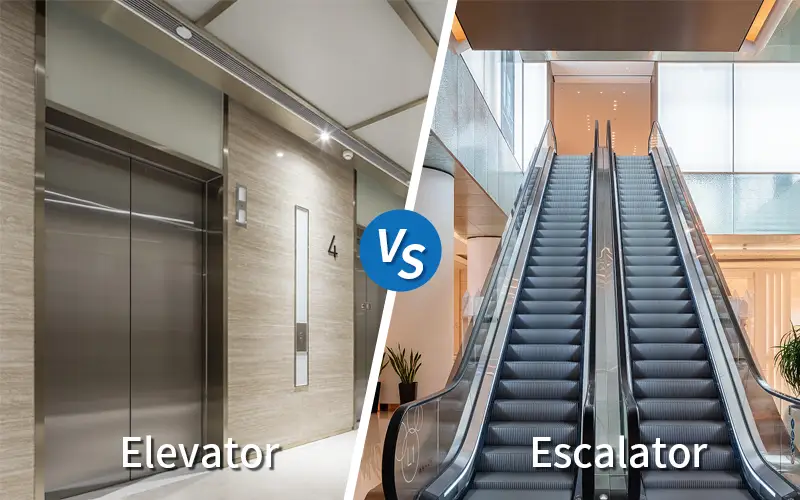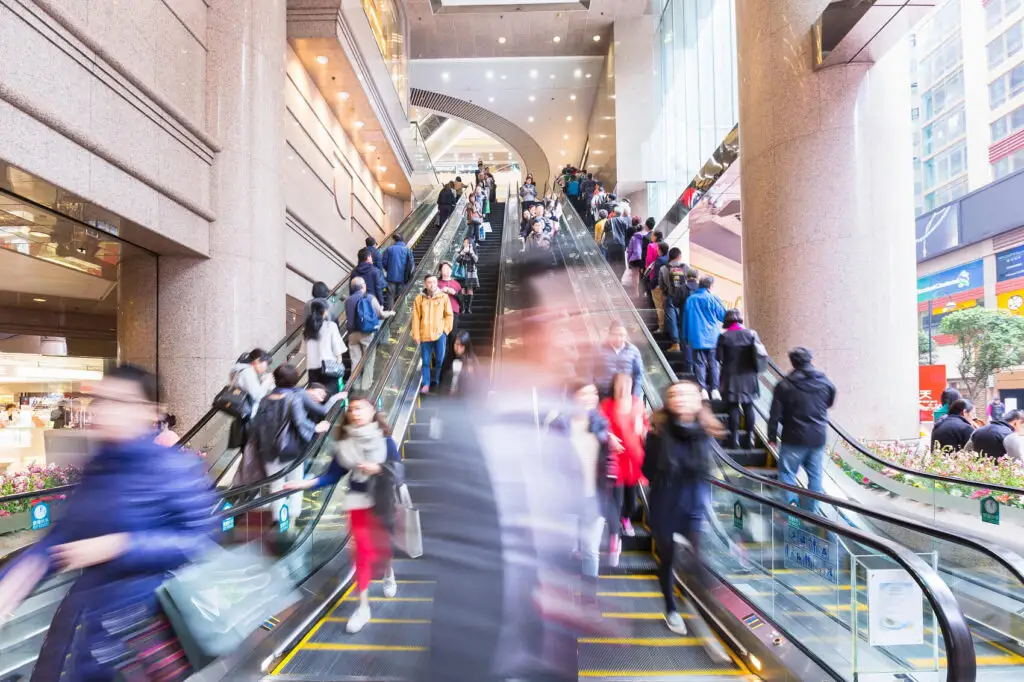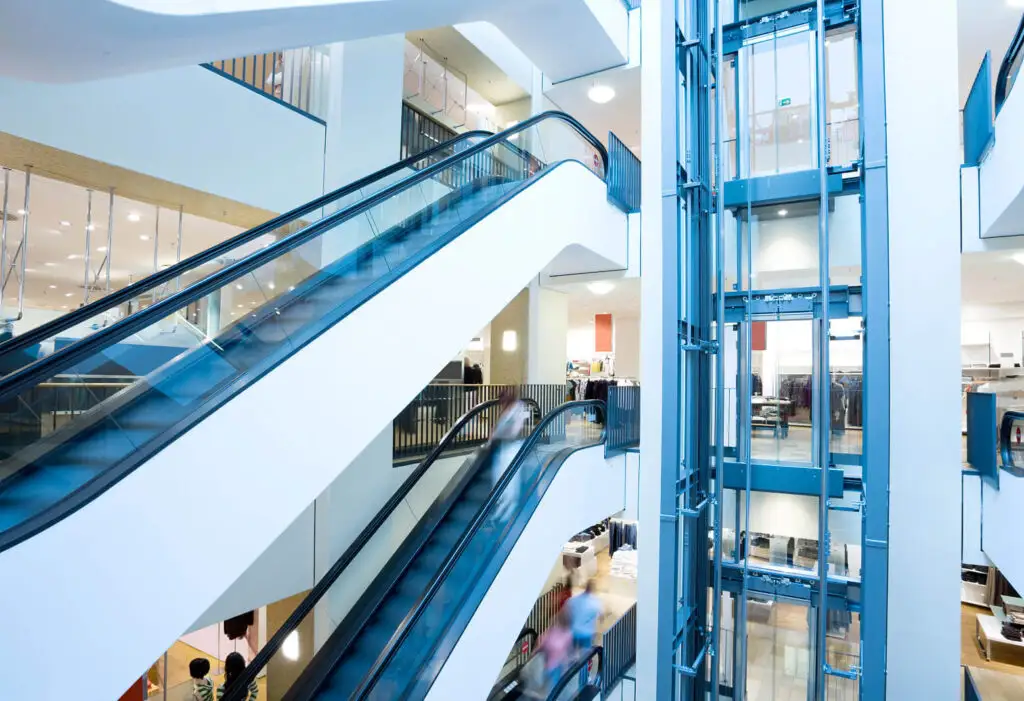
A diferença entre escada rolante e elevador
1. Working principle
An elevator is an enclosed cabin that runs vertically, like a room that moves up and down, to quickly transport passengers or goods to any floor of a building. It uses motors, cables and counterweights to accomplish this.
An escalator is an auto-moving staircase that runs at an incline(usually 30° or 35°). It can only take passengers from one floor to the adjacent floors. It is driven by an electric motor, which drives a chain that moves the steps in a circular motion.
2. Structure and Design
Elevators take up less floor space but require a vertical shaft running through the building, and usually require a machine room on the top.
Escalators take up more space and need a long, diagonal path between floors.
3. Speed
Elevators move faster, from 1.0m/s to 2.0m/s in standard buildings, and even higher in skyscrapers, where they can exceed 10.0m/s.
Escalators move at slower speeds, typically 0.5m/s to 0.75m/s.
4. Capacity
Elevators can carry 6-21 passengers (450-1600 kg) per trip.
The escalators can carry 20 and more passengers at a time, transporting up to 8,000 people per hour.
5. Passenger Transport Efficiency
Elevators are quicker if you need to get to many floors, but you will have to wait in line for one to appear, especially if it is busy. Delays can occur in buildings with high foot traffic due to this.
The escalator always moving. No waiting! You can stand still or walk to go faster, depending on how much you want to hustle.
6. Traveling Height
Elevators is particularly good for tall structures such as high-rise buildings and even skyscrapers. They can go up so many floors
Escalators are more suitable for short movements, specifically covering the distance of a single or at most two floors.
7. Application
Elevators are mainly used in multi-story buildings to transport passengers, patients, equipment and goods, commonly found in office buildings, apartments, hospitals, hotels, warehouses.
Escalators are usually installed in high-traffic areas to transport passengers efficiently, commonly found in subways, shopping centers, and airports.
8. Energy Efficiency
Elevators use energy while starting and stopping, and not when idle. Regenerative drives used in modern elevators absorb and return energy to the building.
Escalators run all the time, even when no people are using them, therefore, they consume more energy. However, the newer systems are equipped with sensors that slow the escalator or make it cease to operate if it is not in use.
9. Manutenção
Embora tanto as escadas rolantes quanto os elevadores transportem pessoas entre andares, os elevadores exigem mais medidas de segurança e manutenção devido ao seu movimento vertical e espaço fechado. Por outro lado, as escadas rolantes têm um design mais aberto e geralmente requerem menos manutenção.


Fatores a serem considerados ao escolher entre elevadores e escadas rolantes
Restrições de espaço
O espaço é significativo ao escolher entre um elevador e uma escada rolante. Os elevadores não podem ser colocados em espaços pequenos como uma escada rolante. Em vez disso, eles precisam de um eixo de instalação específico. Se o espaço for apertado, uma escada rolante pode ser melhor que um elevador porque precisa de menos espaço para ser instalada.
Altura e Design do Edifício
A altura e a disposição do edifício também devem ser levadas em consideração. Se o edifício for alto, pode não haver outra maneira de chegar aos andares superiores. O acesso para usuários de cadeiras de rodas é apenas uma forma de alterar os elevadores para atender às necessidades dos diferentes edifícios e de suas pessoas. As pessoas podem precisar de elevadores e escadas rolantes para se moverem rápida e facilmente entre os andares.
Dados demográficos do usuário pretendido
Também é essencial considerar os dados demográficos das pessoas que você deseja alcançar. Por exemplo, se o edifício for utilizado principalmente por idosos ou pessoas com deficiência, um elevador poderá ser uma escolha melhor. Por outro lado, uma escada rolante pode fazer mais sentido se a maioria das pessoas que utilizam o edifício forem jovens e saudáveis.
Custo-benefício e retorno do investimento
Ao decidir entre elevadores e escadas rolantes, é importante pensar em quanto custará possuir ambos. Embora as escadas rolantes possam custar mais no início, elas geralmente são mais caras para instalar e manter do que os elevadores. Você também deve pensar em quanto dinheiro você acha que pode ganhar de volta. Um edifício com muito tráfego vertical pode obter um melhor retorno sobre o investimento (ROI) de um elevador do que um edifício com menos tráfego vertical.

FAQs About Elevator and Escalator
Which Is Safer, To Ride in an Elevator or on an Escalator?
Both of these are safe. Accidents are uncommon and typically result from improper usage. You have to follow safety rules like holding the handrail on escalators and not overload that elevator.
Which One Should I Choose?
Choosing between an elevator and an escalator will depend heavily on the building’s purpose. Office buildings, hotels, and residential buildings often rely on elevators because they efficiently move people between floors. Their enclosed design also provides privacy and accessibility for all users.
Shopping malls, airports, and transit stations often use both elevators and escalators. Escalators are excellent at moving large numbers of people between adjacent floors, especially during peak hours. They’re also great for buildings with high foot traffic where many people need to move between just two or three floors.
In general, a combination of both is usually best.
Which Costs More—elevators or Escalators?
For the same building, escalators tend to be more expensive. For instance, a 3-story building typically requires at least four escalators (two for ascending and two for descending), whereas only one or two elevators are usually sufficient.
Are Elevators and Escalators Manufactured to the Same Standards?
No. Elevators and escalators are manufactured to different standards due to their distinct mechanical requirements. For example, in Europe, elevators must comply with the EN 81-20 standard, while escalators and moving walks are governed by the EN 115 series of standards (e.g., EN 115-1 for safety requirements).
What Happens to Elevators and Escalators During Power Outages?
Elevators automatically switch to backup power systems that safely bring the cabin to the nearest floor and open doors. For escalators, they gradually slow to a stop, engaging automatic brakes to prevent backward movement. Some premium models have backup power to complete their cycle.
What Is the Difference Between Elevator and Escalator Troubleshooting?
When an elevator breaks down, it usually stops automatically at the nearest floor and passengers can call for help via the emergency call button.
In the case of an escalator failure, passengers can press the emergency stop button and then quickly exit the escalator.
What Is the Service Life of Elevators and Escalators?
The lifespan of an elevator is 15-20 years and an escalator is 10-15 years. However, the exact lifespan depends on the frequency of use and maintenance.
Conclusão
In short, elevators and escalators do different things and are used in different ways. Both have good points.
We understand that every building has special requirements. If you’re planning to install an elevator or escalator in your building and need help finding the right one, Dazen is here to help.
Since 2014, We have been a trusted leader in elevator and escalator solutions, serving clients in over 80 countries. Located in Suzhou, the heart of China’s elevator industry, we bring unmatched expertise in every project. Our commitment to quality is backed by ISO9001-2000, ISO14000, CE certifications, with all core components meeting EN81-20, and EN115 standards.
